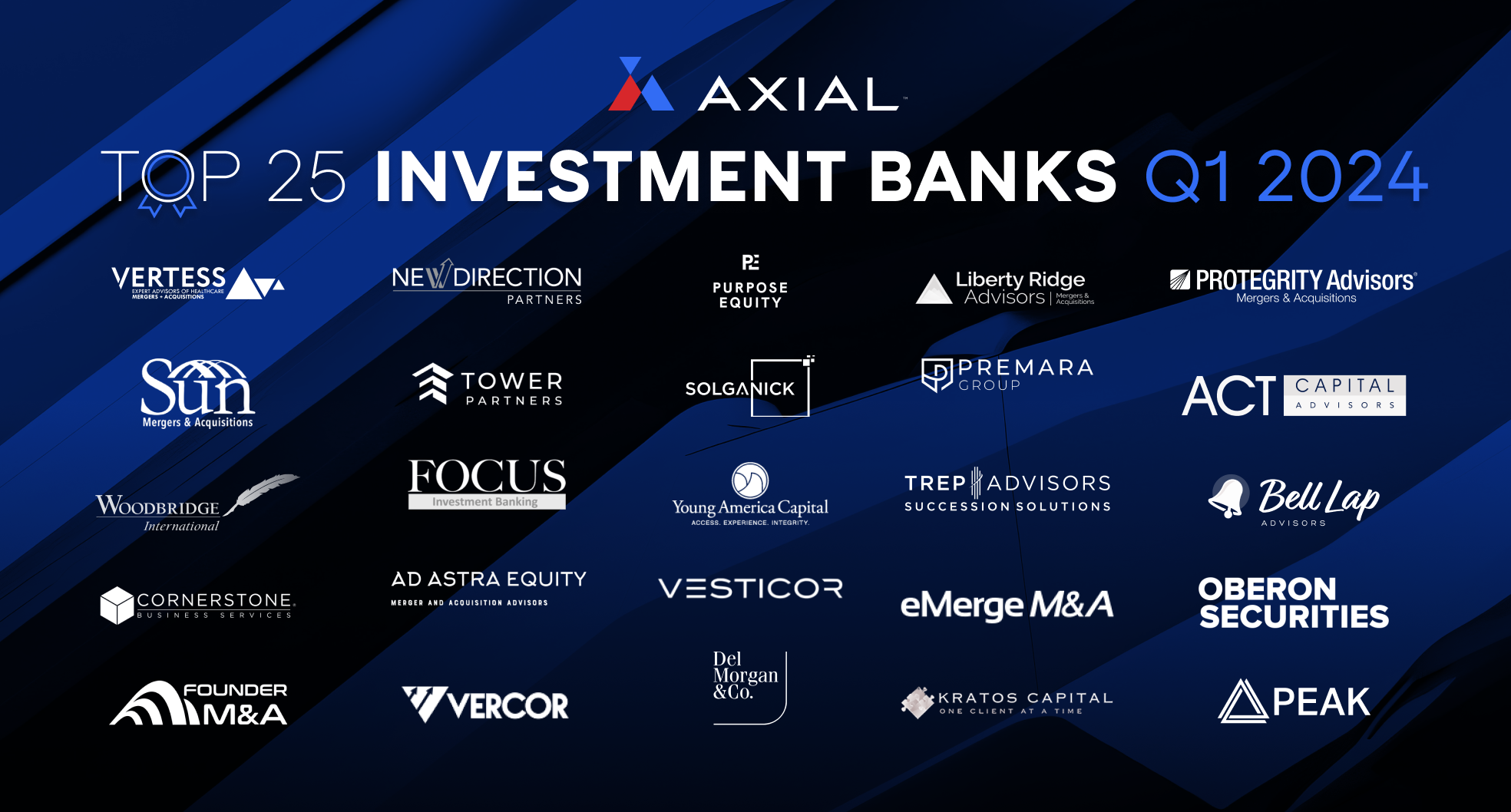
Top 25 Lower Middle Market Investment Banks | Q1 2024
Axial is excited to release our Q1 2024 Lower Middle Market Investment Banking League Tables. To assemble this list, we…
It’s a big leap from being a journalist and a public relations executive to a mergers-and-acquisitions consultant. Or is it?
Randy Coppersmith, the chairman of Cortland Advisors, LLC, an M&A advisory firm based in Florida, says his writing and communications experience, along with his people skills learned from years of reporting and PR work, have helped him deal successfully with buyers and sellers in his current gig.
Coppersmith’s path to M&A advisor was a series of twists and turns, with doors opening as he went along. His career began after he graduated from the University of South Florida with a bachelor’s degree in Journalism and Mass Communications. His dream at that time, he admits, was to be a newspaper writer, which he readily accomplished. Coppersmith worked for six years as a writer for numerous news outlets: The Associated Press, The Tampa Tribune, the Springfield Daily News (in Missouri), and the Sun-Sentinel (in Florida), covering sports, news and politics — until he was offered a PR post at IBM Corp., where he got his first real taste of deal making. Five years later, Edelman, the largest independent public relations firm in the world, stole him away, offering him a senior vice president slot. As the years went by, he also held a few other senior communications positions, including at AOL Studios, a division of America Online, Inc., where acquisitions were key to the company’s growth strategy.
In 2002, Coppersmith shifted radically and became chairman and CEO of Intercom Consulting & Federal Systems, a government contracting company based in Virginia. He helped grow the business significantly over the next 14 years until it was acquired by Belcan, LLC, in 2016. Then in 2017, he joined Cortland. He is now based out of Cortland’s Washington, D.C., office.
Today, Coppersmith has more than 60 sell-side and buy-side transactions under his belt, and as chairman, helps his firm on small- to mid-market transactions, typically working with companies that generate under $100 million in revenue.
Axial recently spoke with Coppersmith about his 44-plus-year career, his firm Cortland, the M&A market, and what he’s learned along the way.
You took an usual career path to get where you are today. How did these transitions occur?
RC: I always wanted to be a newspaper man as long as I could remember. I worked for my high school newspaper and my college newspaper. But when IBM called and offered me a job in New York, at the time Elizabeth and I were expecting our first child, and it was a great opportunity for a career. I did speechwriting, magazine editing and product public relations, and I loved IBM. It was one of the saddest days of my life when I left, but (Edelman’s CEO) Richard Edelman offered me a great opportunity and I took it. At AOL, we did over 50 transactions while I was there, and that’s one of the ways we built up the company, acquiring Netscape [Communications Corp.] and a lot of other content and technologies.
What have you learned about the M&A field?
RC: It’s great to be adroit at financial modeling, but we also need people who have liberal arts backgrounds, and who understand the power of the written word and can communicate effectively. For me that’s been an advantage. I’m not a traditional banker. And I think having deep knowledge of sales helps, too.
What do you find most challenging about M&A advisory work?
RC: One, getting private equity firms to alter or shift their models to meet the demands of the marketplace. A lot of PE firms have a financial business model — “this is what we need to make on this deal” — and as an investor, I appreciate that. But I would like to see more flexibility from the private equity folks, especially in this time when there is so much competition.
Two, getting sellers to really agree that they want to sell. We’ve had some transactions where we got to the alter and the marriage did not get consummated because the seller got cold. It’s a lot of work for nothing. It’s not great for anybody.
The third thing — and this is an observation of mine — is that the government is making an egregious mistake in not increasing the size of the small business set-aside status to $100 million. Most government contracting firms are judged on the total size of all their contracts, and the small business set-aside ceiling for most of those firms is usually around $30 million to $35 million. Above that they are considered a large contractor, and as a consequence it has a chilling effect on a lot of M&A transactions in the space. A $25 million government contractor wants to buy another $25 million contractor, but it will turn them into a $50 million consolidated business, so they’re automatically disqualified from competing for small business set-aside work. If the government would raise the small business ceiling to $100 million, it would precipitate a lot more business in the GovCon M&A space. I hope some friends at the SBA are reading this.
What do you find the most rewarding about M&A work?
RC: When a company is sold and principal shareholders get paid, that’s a tremendously rewarding experience. It’s also rewarding to see entrepreneurs exit and fulfill their dreams. We have a client who had an $8 million business, and in five years he’s turned it into a $70 million company. We will work hard to help him get his firm acquired in the next year. He’s going to make a tremendous amount of money, and this is what he set out to do. If he can do it, why not?
You’ve been involved in dozens of M&A deals throughout your career. Which ones stand out?
RC: There are a lot of them. In the early days with IBM, I worked on the transaction for ROLM [Corp]. I supported the IBM team in due diligence, post-transaction, promotion, marketing, and team structuring. It was the first transaction in my career, and my first time seeing how it worked, watching a buyer acquire a large but much smaller business. I also worked on a number of transactions at AOL, including business development opportunities with The Walt Disney Company and the ABC television network. One more was the sale of Intercom Federal Systems, which is how I got to Cortland. Cortland advised the private equity firm’s portfolio company, Belcan, which acquired my company. Since coming to Cortland, we’ve done a number of deals, including the sale of a software company in Texas, and we recently completed the sale of a research company in Washington, DC, to a larger research company. Now, we’re working on a construction deal that should close in the next couple of weeks.
How has M&A work changed over the years?
RC: In the 40-plus years I’ve been doing this, the business has become way more complicated in terms of lawyers and accountants. Accounting firms representing the private equity companies can sometimes make a transaction overly complex . And that’s why it’s important for business owners to hire someone like Cortland — so they have someone represent their best interests in these talks. M&A is more popular than ever, and private equity has become a “gi-normous” component in the financial services industry, much more prevalent than it was 20 years ago. In fact, recently a study found that 40% of CEOS are considering an M&A transaction as a way of growing their companies.
Cortland focuses primarily on three areas: construction, technology, and government services. What do you see in these three sectors as we head into 2022?
RC: Certainly, we see more of the same for construction. There’s still a chronic shortage of inventory for housing and we may see some conversion of commercial properties into residential houses. So, we don’t see a slowdown in the short term. What will slow construction down is an increase in interest rates, but even at 4% next year, we’ll see plenty of M&A action. The infrastructure bill is also creating a trillion dollars’ worth of opportunity. Technology continues to be very strong. We don’t see any slowdown in technological use — if anything, it’s continuing to increase. And we think government contracting will continue to be very strong into the foreseeable future. We like the verticals we are in.
Construction in particular is a hot market right now. Why do you think that is?
RC: It’s a combination of things. There’s a tremendous amount of capital available in the market today. In my 44-year career, I’ve never seen anything like this. People are looking for assets to invest and frankly, the pandemic has made a lot of people re-evaluate their lifestyle, and how they want to conduct business from home. They want to get out of the city, so it’s a whole combination of things at the right moment at the right time. And interest rates are at near historic lows, so private equity, family offices, and institutional investors are all looking for deals because they can finance them readily.
How would you describe an ideal client?
RC: Obviously we like companies with strong balance sheets, strong customer relationships, and strong management teams. It’s important that all the owners of the business — and many of these businesses have multiple owners — agree that this is what they want to do. You’ve got to get everybody on the same page.
How do you connect with buyers and sellers eager to do deals?
RC: We work with accounting firms, law firms, banks, and wealth management firms that refer business to us. Almost all of our work is referral. Believe it or not, customers are often a great source of new business referrals. We don’t do any kind of cold calling. Our buy-side practice is very busy. But the majority of our current book are sell-side engagements. We’re constantly talking with private equity buyers who are hungry for deals.
How do you handle clients who are first-time sellers?
RC: Pretty much everyone who works at Cortland has been there and done that. Almost all of us are ex-CFOs, CEOS, attorneys, CPAs, and have been involved on both the seller and buyer sides. There’s a lot of coaching, hand holding, pop psychology — and we help them find the benefit of this for themselves and their family. We have them sit down with a wealth advisory partner and figure out what the magic number is for them to retire. The magic number to retire is often less than what they think their company is worth, which makes it a lot easier to go forward with a deal.
What makes a great M&A advisor?
RC: They understand the transaction economics, the financial component of it. They understand the sales and marketing component of it. You have to sell the buyers on these deals. You’ve got to be able to deal with the clients and all of their staff issues accordingly, and you’ve got to be pretty good at finding new clients. It’s rare to find someone who can do all of that. If you find that person, grab ’em. Or call me — we’ll hire them.
What advice would you give to buyers or sellers looking for a deal?
RC: First of all, it’s the fool who represents themselves as a client. I can’t say it any more plainly. If you are a dentist, you wouldn’t operate on yourself. If you’re a lawyer, you wouldn’t represent yourself in court. It’s just silly. The truth of the matter is, not only do we earn our fees, but we increase the value of the transaction and that increase almost always covers our fees. It’s just smart to hire a professional M&A advisor. And we like to work with smart clients.
